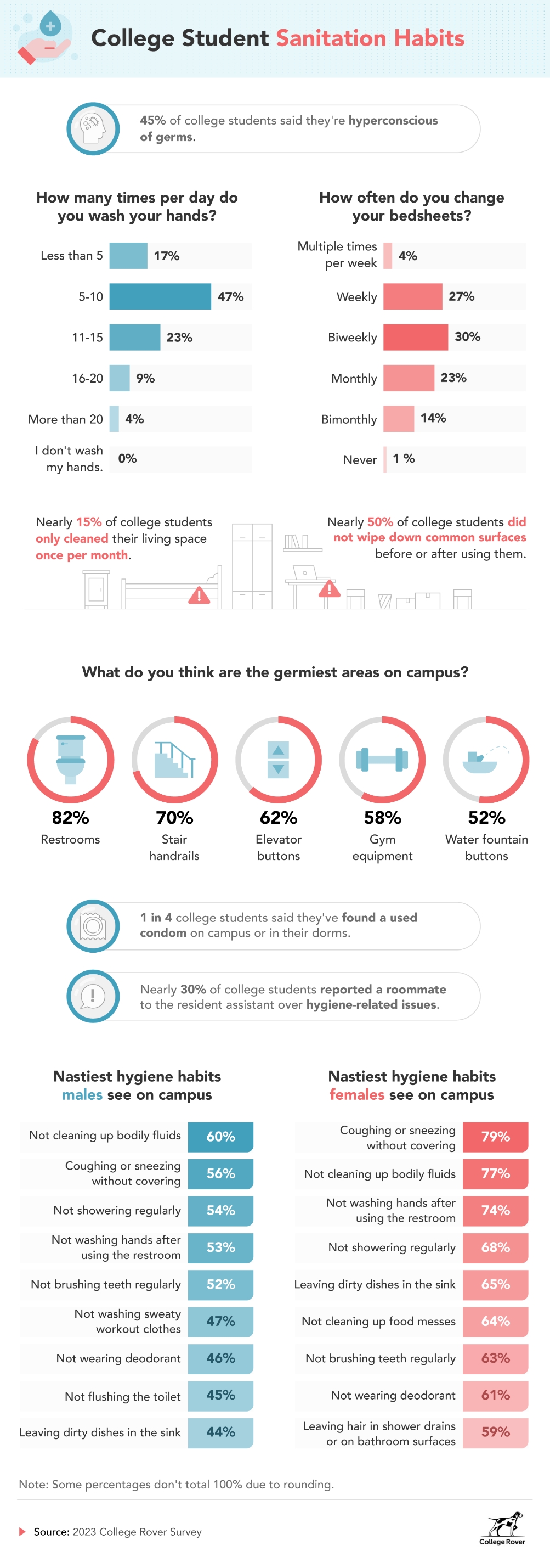Key takeaways
- On average, college cafeteria tables had 60,000x the bacteria of a household toilet seat.
- Nearly 15% of college students only clean their living space once per month.
- Nearly 50% of college students do not wipe down common area surfaces (e.g., desks, tables, keyboards) before or after using them.
- 1 in 4 college students have found a used condom on campus or in their dorms.
- Nearly 30% of college students have reported a roommate to the resident assistant over hygiene-related issues.
How germy is the average college campus?
If you ask a group of college students about their plans for the weekend, deep cleaning the dorm room may not be among the most popular answers. How dirty are college campuses and dorms, and should students include cleaning in their study schedule?
To find out how germy college campuses are, we swabbed everything from campus public bathrooms to dormitory common areas to computer lab keyboards. We then ran our swab collections through gram and stain tests to identify the types and numbers of germs on college campuses.
We also surveyed 1,000 college students about their hygiene habits and the nastiest stuff they’ve seen on campus. So grab a bottle of sanitizer and read on to discover some unsavory truths about college living.
Bacteria breakdown: Germ types and where they lurk
As you may or may not remember from high school science class, not all germs are created equal. Let’s take a quick look at the various types of bacteria we encountered in our swab study so you can be properly grossed out as you review the results.
Gram-negative rods and gram-negative rods, type II
According to the National Library of Medicine, gram-negative bacteria are the most dangerous because they tend to be exceptionally resistant to antibiotics. Some gram-negative rod and type II infections include salmonella, E. coli, Legionnaires’ disease, and urinary tract infections.
Gram-positive rods
Gram-positive bacteria are generally less dangerous than gram-negative bacteria because they respond to antibiotic treatment. However, gram-positive infections can still be highly dangerous for individuals with weakened immune systems. Some gram-positive rod infections include colitis, diphtheria, and botulism.
Bacillus
Bacillus is a specific type of gram-positive rod bacteria. They are (mostly) harmless to humans but lead to food spoilage and can cause some nasty food poisoning. Additionally, one particular strain of Bacillus causes anthrax.
Now let’s find out how many of these nasty bacteria are waiting to infect the student body.

Public bathrooms were the germiest area of all the campus hot spots we swabbed. With 47 million colony-forming units (CFU), 64% gram-negative rods and 34% type II, campus bathrooms were home to more would-be infections than a Saturday night frat party.
While germy bathrooms weren’t surprising, campus laundry rooms were shockingly germ-infested, with 30.5 million CFUs: 98% gram-negative rods and 2% bacillus. Laundry rooms were even more germy than campus cafeteria tables, which had 100,000 fewer CFUs.
College library desks were the cleanest area we found, but that’s not saying much. With 29.2 million CFUs, most bacteria found on library desks were gram-positive rods (96%), which can at least be treated easily with antibiotics. Still, students who aren’t interested in hosting a study group for germs might want to use some antibacterial wipes before hitting the books.
Battle of the bacteria
College may not be the most germ-free environment, but what’s a few million CFUs between friends? Below you’ll get a better idea of how significant college bacteria levels are as we compare them to bacteria found back at home.

To compare college campuses with the average household, we collected swab samples of common places germs hide in your home, such as toilets, pet bowls, and kitchen sinks. While some household surfaces proved pretty gross, they all shined compared to their college surface competitors.
College students love a good dining hall meal, but the average college cafeteria table hosted 60,000 times more bacteria than the average household toilet seat. Students with meal plans might want to take their food to-go or order campus delivery.
One of the dirtiest places in most households is the kitchen sink, with an average of just under 11.4 million CFUs — but that’s nothing compared to college library desks which had 2.6 times more bacteria. Things got even worse when it came to the average computer lab mouse and keyboard, where we found 12 times the amount of bacteria as a household toothbrush holder.
Dude, take a shower
In addition to our bacteria swab study, we surveyed 1,000 college students about their hygiene habits. Let’s see if students make the grade when it comes to college cleanliness.

Nobody wants to be the smelly guy on campus or the nightmare roommate, but it takes some effort to keep things clean without your parents around to nag you. This might be why nearly 15% of college students only cleaned their living space once per month. But if you want to get a fresh start next semester, it’s worth exploring how to deep clean your dorm room now and then.
Staying clean and tidy can also help avoid run-ins with your roommates, as nearly 30% of students reported a roommate to their RA over hygiene-related issues. And as almost half (45%) of the college students surveyed said they were hyperconscious about germs, there’s a good chance at least one of your college roommates will get furious over filth.
Even if your roommate doesn’t mind your mess, other students on campus might cringe at your lack of cleanliness. Female students were particularly grossed out when people coughed or sneezed without covering; nearly 4 in 5 said it was the nastiest hygiene habit they saw on campus.
Second to spewing sputum, 77% of females and 60% of males said not cleaning up bodily fluids was the grossest hygiene habit. Given that 1 in 4 college students reported discovering a used condom on campus or in their dorms, it’s worth reiterating that leaving behind your DNA is no way to win friends.
Students saw other nasty hygiene habits like not washing hands after using the restroom, not showering or brushing teeth regularly, and not flushing the toilet. Despite this, almost 50% of students said they never wipe down common area surfaces before or after using them. Ew.
Cleaning up on campus
College campuses are places of learning, self-discovery, relationship building — and rapidly breeding bacteria. While you can’t control the hygiene habits of every other student on campus, you can do plenty of things to keep yourself healthy. The CDC offers a solid list of germ-prevention tips that can go a long way toward dodging harmful bacteria. Remember to wash your hands, keep your space clean, and shamelessly pull out those antibacterial wipes before you sit anywhere on campus.
Methodology
We conducted three-gram and stain culture swab tests across college campuses. Each surface was swabbed three times. CFUs per swab were averaged for each surface type. It is possible that with a larger sample size of surfaces, we could have gained more insight into CFU levels. No statistical testing was performed, and the above claims are based on means alone. As such, this content is exploratory. Bacteria definitions were sourced from ncbi.nlm.nih.gov, britannica.com, and sciencedirect.com.
Additionally, we surveyed 1,000 college students about their hygiene habits. Among them, 36% were male, 59% were female, and 5% were non-binary.
About College Rover
College Rover was built to offer students and guardians an easy way to sort through mountains of information on various colleges. Sort and filter schools by your personal preferences to find the perfect college for you.
Fair use statement
Concerned about the germs at Georgetown or the bacteria at Ball State? Feel free to share this article for noncommercial purposes only; a link back to this page must be included when doing so.






















